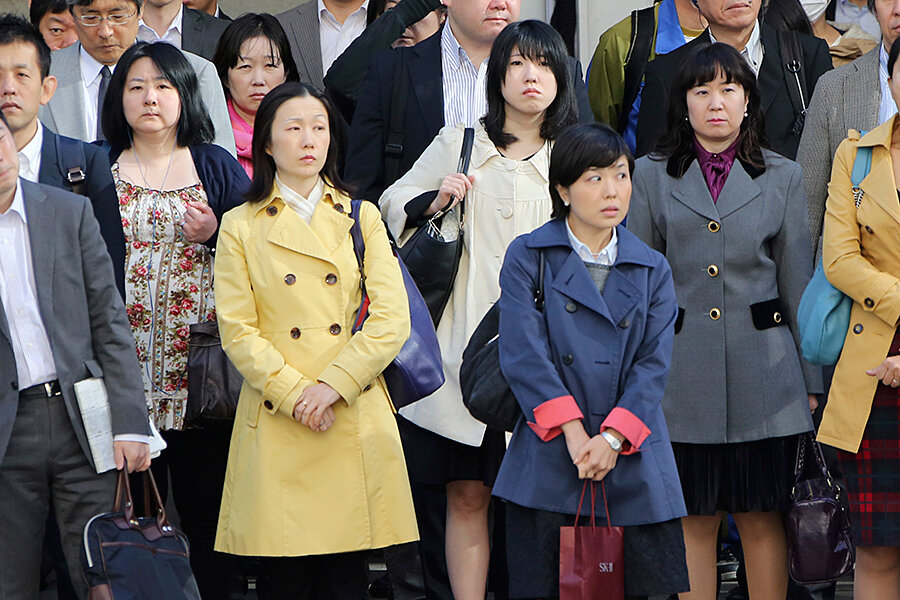Japan's shining path to promote women leaders begins to dim
| Tokyo
Back in 1989 when Kumiko Kosugi joined a large IT services company, female employees wore uniforms and did simple office work – when they weren't making tea for colleagues or clients.
Ms. Kosugi assumed she would marry and leave her career behind. Instead, a quarter of a century on, she's a senior manager and her company is rated as having the best working conditions in Japan.
In some ways, Kosugi is a perfect example of Prime Minister Shinzo Abe’s much-touted effort to champion Japanese women as a key to boost the economy and to offset a low birth rate and a labor force that is losing a million people annually.
Mr. Abe’s so-called “womenomics” reform is a pillar of his economic plan, often dubbed "Abenomics." As recently as Sept. 27 in a speech to the United Nations on gender equality, the prime minister spoke of females taking 30 percent of the leadership roles in Japan by 2020, an official target.
Yet Abe’s shining path for greater female participation is dimming substantially. This month the government slashed its 30-percent target to just seven percent, recognizing that it was nowhere near its original goal.
Even the kind of transformation seen at Kosugi’s company, for example, has not kept pace with change among Japan's economic peers. And analysts warn that such fitful reforms may be too little to avert a looming demographic and fiscal crisis.
Challenging patriarchy
Japan’s public finances are creaking under the weight of government debt equivalent to around 240 percent of its GDP. Servicing that debt is going to become increasingly onerous as its tax base shrinks.
The ambitions of "womenomics" sits awkwardly with Japan's traditional patriarchy. Last summer, members of Abe’s party heckled a female lawmaker in the Tokyo city council, calling out, “Hurry up and get married,” and “Can’t you bear children?” The lawmaker who jeered the loudest later apologized but did not step down.
In the annual Global Gender Gap Index 2015, published by the World Economic Forum, Japan ranked 101st out of 145 countries. On the index’s economic and participation benchmark, Japan ranked 106th, while for women in parliament it came in a lowly 125th. Indeed, since Abe's party was returned to power three years ago the number of female lawmakers and cabinet members has actually fallen.
According to a report by the Organization for Economic Co-operation and Development, Japan’s workforce is set to fall by 17 percent from current levels by 2030, and 40 percent by 2050. However, if female workforce participation were to rise to that of Japanese males, the decline would be only 5 percent by 2030.
There's a growing consensus here that Japan needs to foster a society in which women find it easier to both have more children and fully participate in the workforce, particularly after becoming mothers.
But bringing levels of female participation and status in Japan up to those of other advanced industrialized nations would require changes in corporate culture, legislation and societal attitudes, including among women themselves.
"There are still not that many women who want to be managers; some of those selected for promotion in my company turn it down. Women aren't brought up to be managers. When I was a child, people still talked about wives walking three steps behind their husbands," says Kosugi.
She says the government's previous target was unrealistic. At her company, women make up around 5 percent of employees, which is above the national average of 3.5 percent.
Policy runs ahead of practice
Another female manager, who asked not to be identified, says that where works – a Japanese corporation in the medical field – only 1.5 percent of those in management are women.
When she had her first child in 2004, the manager had aimed to be promoted to section chief. Even though the company had just adopted an official policy of increasing the number of female managers, she was advised by senior management not to apply if she intended to start a family.
Ignoring the warnings, she won promotion.
"I was extremely lucky that my immediate boss was a woman with children, the only one in the company. She was very supportive and seeing her working and succeeding, she was a great role model for me," she says.
By the time she had a second child four years later, she says, conditions were much better. But when her husband was transferred to Osaka, she faced a dilemma over childcare that was only resolved when her mother moved in. Even now, with her husband back in Tokyo, her mother comes to look after the children if she assigned to overseas business trips.
Affordable childcare is a major barrier to women moving up the corporate ladder in Japan.
A working mother in her mid-40s, who also asked to remain anonymous, said some of her colleagues at her education firm, where she manages language courses, were less than supportive.
Returning to work after maternity leave, female coworkers made life difficult when she took time off to look after her sick daughter. "She had children, but had returned to work after they had grown up, and didn’t realize how tough it was," she says.
"Though the company’s policies for working mothers were very generous, the actual system and people’s attitudes weren’t so good."







